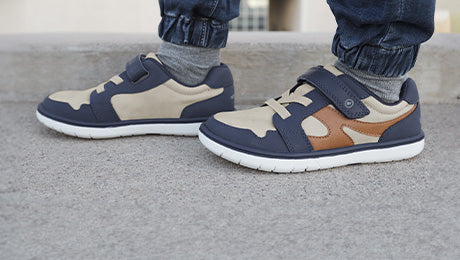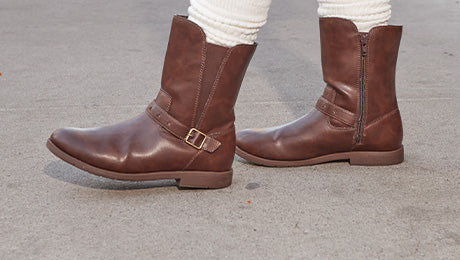Kids' Shoe Fit Guide
Properly fitting shoes are a must-have for babies, toddlers and kids of all ages. Wearing footwear that isn’t well fitted or properly designed for their delicate, growing feet can lead to poor development and foot problems down the road.
In fact, a recent study by The College of Podiatry shows that nearly 30 percent of children in the UK are wearing the wrong size shoes, which could permanently damage their feet!
As your child starts to explore the world around them, make sure their shoes support them every step of the way. Learn everything you need to know about properly fitting kids' shoes with this guide.
Here's what our fit guide covers: Click on a topic below to jump straight to that section.
- The anatomy of a baby's foot
- The anatomy of a toddler's foot
- What happens when their shoes don't fit
- How to properly fit kids' shoes
- Fitting tips and tricks for parents
- Signs your kids' shoes are too small
- Signs your kids' shoes are too big
The anatomy of a baby's foot
Babies' feet are soft, fat and flexible – that's why we just can't get enough of them! These little bundles of cartilage haven't fully formed into bones yet, and they can grow a half size or more every 2 months!
In the first 24 months, your baby’s feet need as much sensory input as possible to develop the proper muscles and bone structure. Keeping your baby barefoot or in socks whenever you can, exposing their feet to different kinds of surfaces, and giving little foot rubs are all good for growing feet!
When you do need to put your baby in shoes, it’s important to select a pair that’s light, flexible and supportive of their natural movements. Take a look at our Soft Motion baby shoes, which are made specifically for this stage of development.
The anatomy of a toddler's foot
By the age of two, your child’s feet will look a lot more grownup. The bones solidify, and their tootsies lose the trademark pudginess of baby feet.
Toddler feet continue growing at a rapid rate – about a half size every 2-3 months. During this stage of development, early walkers develop fine motor skills and balance as they practice crawling, rolling, walking, climbing, jumping and every kind of movement you can imagine!
Toddlers need shoes that enhance proprioception, which is the way joints and muscles send messages to the brain to help coordinate movement. Their feet should stay low to the ground and supported so they can get all the sensory feedback they need. That’s why our SRtech shoes for early walkers include memory foam footbeds and unique sensory pods on the soles.
Many little ones remain flatfooted throughout toddlerhood. Their arches may not fully develop until around their fifth birthday. Generally, flat arches are normal for toddlers and not a cause for concern. But if your child complains of pain or you observe extreme pronation or misalignment, have their feet checked by a podiatrist.
What happens when their shoes don't fit
Despite the delicate nature of children’s feet, lots of kids' shoes on the market aren’t actually designed to support proper development. Bruises, blisters and irritation are frequent side effects of ill-fitting footwear.
Because kids' feet continue to develop as they start wearing shoes, children who wear improperly fit or poorly designed shoes for too long are also at risk for long-term damage. Side effects can include pain, inflammation, vein problems, shortening of foot muscles, and even dystrophy in extreme cases. That's why it's so important to find the right fit.
Properly fitting kids' shoes
Know their size
First thing's first – make sure you know your kid's current shoe size! Because baby and toddler feet can grow half a size or more every few months, you should measure their feet every 2 months to avoid putting your child in shoes that are too small.
Use our size guide to make sure you've got the perfect size shoes for your little one's feet.
Once your kid has the right size shoes, here's how to make sure they fit.
Places to check
Width
Have your child stand up with both shoes on. Check to see if the shoe fits their foot's shape by feeling for any pressure against the widest parts of their feet. The ball of their foot should be comfortable and snug all the way around, without any pinching or irritation.
Depth
To ensure proper depth, run your thumb over the shoe's top. You should feel the fabric ripple slightly. If the fabric is too taught, the shoe may not be deep enough. But if you can pinch the fabric into a ridge, it's likely too deep.
If your child is trying on a low cut shoe like a Mary Jane, feel how much space there is between their toes and the top of the shoe, or vamp. A wide gap means the shoe is too deep. If their foot presses uncomfortably against the vamp, the shoe is too shallow.
Length
Press the tip of your thumb against the toe of their shoes to check length. Your kid's toes should have enough room to wiggle around without pressing against the front of the shoes, but not so much room that their feet can slide forward.
Arch
Arch support isn't necessary during the first five years of development – in fact, anything that prevents the foot from feeling the ground can actually hinder proper development. The arch of a kids' shoe should cradle your child’s foot and promote sensory feedback without causing discomfort or misalignment.
Ankles (toplines)
Check your child's ankle bones. Unless the shoe has a soft, paddled collar, the topline shouldn’t touch or rub against their bones.
Back (heel slip/heel grip)
The shoe’s back should grip their heel snugly, without digging into it. When fitting your kid for their first walking shoes, hold the heels of their shoes in your hand and gently try moving them up and down. If their heel slips out, try tightening the closures to keep the shoes on. If their heels still slip out, you might need a different size.
For early and independent walkers, watch their heels as they walk away from you. Make sure their feet aren't slipping out or getting pinched in back.
Closures
Take a look at the shoe straps. Because kids' feet change constantly, you want shoes with adjustable laces or hook-and-loop closures that let you customize the fit.
Walking/movement
Have your kid walk, run, jump and move around in their shoes. If you notice any stumbling or a change in their natural gait, readjust their shoes and try again. If their movement doesn’t improve, double check that you have the right size, or try a different pair of shoes.
When fitting older kids for shoes, ask them how each specific part of the shoe feels on their foot. Kids' shoes should feel comfy from the very first time they're worn.
What to look for in a shoe
There are a lot of shoes made for kids, but not all of them are good for kids' feet. Stride Rite works hard to design shoes that encourage natural movement – we're proud to have earned the American Podiatric Medical Association (APMA)'s Seal of Approval for products that promote good foot health.
Length and width
As they transition from chubby baby feet into more of an adult foot shape, many kids' feet have a little extra width. Any kids' shoes you buy should take both length and width measurements into account. Their shoes should have enough space in the toe box for a comfortable fit all the way around.
Shape of the toe box
The toe area of kids' shoes should mimic the natural shape of a child's foot. Look for shoes with soft, rounded edges rather than overly hard, pointy or tapered toes.
Height of the heel
Kids need to be able to feel the ground with their feet. Buy shoes that keep their feet low to the ground, and avoid overly firm or tall outsoles that restrict movement and sensory feedback.
Hold of the foot
Your kid’s shoes should have closures that hold their feet securely, with no extra effort on your child's part. If a kid has to grip their toes or move unnaturally to keep their shoes from falling off, it could interfere with proper foot development.
Support
Pick sturdy, supportive shoes that offer sensory feedback without crumpling or collapsing when your child walks. Ballerina flats, plimsolls and other slip-ons that mimic trendy adult styles may look adorable, but they might not provide the right kind of support. Only buy shoes designed with the real needs of kids' feet in mind.
Material
Leather is a great material for children's footwear because it's durable yet soft, and sturdy yet flexible. Many of the shoes in Stride Rite’s Soft Motion and SRtech collections are made from genuine leather for high-quality construction you can count on.
Other good materials to look for while shopping include breathable mesh and antimicrobial linings that cut down on stinky-feet syndrome. And since no kid can avoid getting into a few messes here and there, buying a pair of machine-washable shoes is always a plus!
Fitting tips and tricks for parents
We could go on all day about the dos and don’ts of shoe shopping with kids. When it comes to finding the perfect fit, here are a few of our favorite hacks:
- Don’t measure in the morning. Feet naturally swell during the day. So, it’s best to try on new shoes after kids have been running around for a few hours.
- Don't buy shoes that are too big. Putting a kid in shoes that are too big can have unintended consequences when it comes to proper foot development. Kids' feet do grow fast, but putting growing feet in the wrong size shoe just to get a few months of extra wear really isn't worth the risk.
- Don't buy them too small, either. The one exception to the rule of buying true-to-size is when your kid's feet are two different sizes or in-between sizes. In either case, always go with the bigger size to avoid squishing their feet!
- Do get involved. You know your kid best. During a shoe fitting, ask your kid how the shoes feel on their feet, and check each area of the shoe yourself to made sure they fit just right.
- Do more than stand and walk. The best way to gauge a shoe's true fit is to watch them in action. Ask your kid to jump, dance and jog around when they're trying on shoes so you can see how they move.
- Do get a second opinion. Get hands-on help finding the right fit for your kid's new shoes at any Stride Rite store. Our Fit Experts are trained to know all the right places to check.
Signs your kids' shoes are too small
Here are some telltale signs that your kiddo has outgrown their shoes:
- Their shoes cause blisters or press deeply into the skin.
- Their toes are jammed against the front of the shoe. There should always be enough space in the toe box to press the tip of your thumb down without hitting a toe.
- Your kid appears less active. If your kid doesn't feel like playing outside as often, it could be a sign that they just don’t want to put on those uncomfy shoes they've outgrown!
- They tell you that their feet hurt! Bigger kids will let you know if their shoes are bugging them. If your kid starts complaining of knee, hip, back or joint pain, it could also be a sign of ill-fitting shoes.
Signs your kids' shoes are too big
Shoes that are too big can be just as bad for kids' feet as overly small shoes. Here are some clear signs that they might need to go down a size:
- Their heel lifts out of the shoe when they walk.
- They trip or twist their ankles often.
- Their walk is affected.
- They drag their feet.
- They get blisters. Yes, blisters can form when shoes are too big, too!
Got more questions? Check out our FAQs to learn more about Stride Rite shoes and how to encourage your kid's healthy development.

 Why Stride Rite?
Why Stride Rite?




